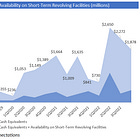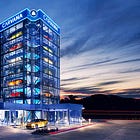Carvana: Still Cheap
It has been a while since my last Carvana post. I wrote the following seven posts between October of 2022 and February of 2024, highlighting why I thought the company’s stock was a good investment. The stock price on the lowest publication date was $7.36 per share (3/28/23) and on the highest was $52.39 per share (2/8/24).
Carvana’s stock was the single best-performing stock in the world (as far as I can tell) in 2023, appreciating 1,017%. The stock gained another 284% in 2024. That’s a cumulative 4,190% increase over those two years, which is a 42.9-fold gain.
Simply put, Carvana is crushing it. They recently reported their fourth quarter 2024 results, which showed retail units grew 50% year-over-year. Keep in mind this is a U.S. used car market that is growing at a low single-digit rate. Non-GAAP GPU was $6,916, up from $5,730 in the year-ago quarter. Non-GAAP SG&A grew 14.9% year-over-year due primarily to the variable costs of growth, but sank on a per unit basis to $3,777—down from $4,942 in the year-ago quarter. That was due to the meaningful fixed cost leverage inherent in Carvana’s model. With GPU up and SG&A per unit down, adjusted EBITDA per unit jumped to $3,139 from $789 in the year-ago quarter. Adjusted EBITDA was $359 million in the quarter, up from $60 million in the year-ago quarter.
For the year, Carvana generated almost $1.4 billion of adjusted EBITDA and $404 million of GAAP net income. For anyone not paying attention, this is a truly massive improvement over just two years earlier when Carvana ran into a “perfect storm” of headwinds, causing adjusted EBITDA of negative $1.0 billion and GAAP net loss of $2.9 billion.
Big picture, Carvana is now the most profitable used car retailer. It’s also the fastest growing used car retailer by far. It still only has just over 1% national market share of used car transactions, suggesting a long runway to grow. And its competitive position could not be stronger. The failures of Vroom, who tried to copy Carvana’s vertically-integrated model, and of Shift, who tried an outsourcing model truly highlights that there is no serious competitive threat to Carvana. The industry is so fragmented that Carmax, who is the largest used car dealer (for now), has only 2% market share. And the top 100 used car dealers have a low double-digit share.
Carvana is the first and only fully vertically-integrated online used car model, which allows it to streamline the customer experience and “own” the full transaction from beginning to end. And now, as a result of its unique model and its efficiency initiatives of the last two-plus years, it has the best unit economics in the business by far. No one else makes as much money per car as Carvana does and the gap is even wider when considering the incremental car sold and the variable expenses associated with that. The flexibility to pass some of that along to customers or let it drop to the bottom line is a massive competitive advantage. The business is also operating at roughly one-third of its existing capacity, meaning its current financials are burdened by those costs and not yet reflecting mature profitability.
Model
Here is my short-term model for Carvana:
Walking through some assumptions for 2025, I start with a 46% retail unit growth pace. That is a slight downshift from the fourth quarter’s pace but in line with where the alt data is year-to-date. Management has guided to “significant” retail unit growth this year, including a sequential increase in the first quarter.
From there, we go to GPU. After some dramatic gains here, most of the juice has been squeezed out of GPU at this point. Management says there are more fundamental gains to achieve, but also suggests that most of them will be passed along to consumers, presumably through lower prices, higher bids for cars from customers, and/or better service. My numbers shake out to $7,086 of non-GAAP GPU for the year, slightly lower than the $7,196 for the full year 2024.
From there, we go to SG&A. You can come at this two ways. First, you can model it using the individual components of SG&A (compensation and benefits, advertising expense, market occupancy costs, logistics, and other overhead). Or, you can focus more on the fixed versus variable cost disclosure that management began providing not too long ago. I think the latter makes more sense, especially given management’s commentary.
Management said Overhead expenses should grow at a mid-single-digit rate this year. So I have that at 5.0% for the year. Wholesale Marketplace Operations, which is the ADESA auction business, has had quarterly SG&A expenses of $15 million for a while, so I assume that continues. As for advertising, I assume incremental advertising per unit of $300, which results in $288 million of advertising spending for the year. And finally, we get to the big variable piece called Retail and Wholesale Vehicle Operations (“operations expense”). In the fourth quarter, this was $1,696 per unit but $1,045 on an incremental basis; that is, the expense jumped $40 million year-over-year while retail units sold jumped 38,289. It was also $1,084 on an incremental basis in the third quarter. Prior to that, the incremental numbers seem pretty meaningless because the company was not yet in true growth mode where the expense in dollars was growing meaningfully as a result of the growth in retail units. There was also almost $9 million of non-recurring annual bonuses in the fourth quarter, some of which fell into this line item, so the fourth quarter’s $1,045 is probably somewhat inflated by that. Nevertheless, I’m modeling $1,050 of incremental operations expense per unit. That drives overall operations expenses higher given the retail unit growth I’m assuming, but operations expense per unit down from $1,739 last year to $1,519 this year. This logic gets me to non-GAAP SG&A of $1.912 billion for the year.
In the model above, I simply tweak the individual SG&A components each quarter such that non-GAAP SG&A matches what I came up with in the fixed/variable section. The most variable part of SG&A is compensation and benefits, so that is where I assign the bulk of the dollar cost growth.
This all results in $2.4 billion of adjusted EBITDA this year, which works out to $3,969 per unit. Management guided to cash interest expense of about $340 million this year and $140 million of capex. That’s being driven slightly higher by 10-12 conversions of ADESA auction sites into Carvana “mega-sites” that include reconditioning, which costs $2-$3 million each. An an aside, Carvana appears to be adding about 30k units of reconditioning capacity per mega-site at a cost of only $2-$3 million. If they convert all 56 sites adding 1.7 million units of reconditioning capacity, it would appear to cost about $140 million. That is an exceptionally low cost.
The sell-side consensus estimate is $1.8 billion of adjusted EBITDA at the moment. So I do expect Carvana to exceed consensus estimates this year, but I’m certainly not writing $2.4 billion in stone. In my prior posts, I was harping on how poorly the sell-side was modeling the growth and operating leverage of the business. But I no longer think it is quite as egregious. The difference between $1.8 billion and $2.4 billion is still meaningful, but a) I could certainly be off, and b) both numbers now reflect the reality that Carvana has made massive progress, is now nicely profitable and cash generative, is out of the woods from a liquidity perspective, and is clearly back on a path to a very bright future.
Valuation
I’ll save my scenario analysis and DCFs for another day. But here’s how I would demonstrate the stock is still cheap. I think Carvana can eventually sell many millions of retail units annually, but two million retail units is a decent interim stepping stone to consider. I think they should be able to do that in 4-6 years, which would imply 30%-48% average annual retail unit growth rates. They just grew retail units 50% in the fourth quarter and the alt data shows them up about 47% so far in the first quarter, so I think 30%-48% is not aggressive.
I think they can conservatively achieve incremental adjusted EBITDA of $5,000 per unit. They did over $10,000 of incremental adjusted EBITDA per unit last year, but that will clearly moderate given efficiency gains can’t continue forever at that pace. From a bottom up perspective, the assumptions I used above about operations expense jive with an incremental adjusted EBIDTA per unit of about $5,350, but I’ll call it $5,000.
Selling an incremental 1.58 million retail units at $5,000 of incremental adjusted EBITDA per unit suggests a total of two million units and $9.3 billion of adjusted EBITDA ($4,648 per unit) annually in 4-6 years. All things considered, I think that could convert to something like $6.6 billion of real cash flow to shareholders, assuming a 25% tax rate.
Given a long runway to continue growing, capitalizing that at a 2.5%-3.0% free cash flow yield would suggest a future equity market value of $219 billion to $329 billion. Whether we discount that back to the present over four, five or six years changes the present values as follows:
If it takes six years, the equity is worth $124-$149 billion, which is $579-$695 per share.
If it takes five years, it’s worth $136-$164 billion, which is $637-$764 per share.
If it takes four years, it’s worth $150-$180 billion today, which is $700-$841 per share.
Any excess free cash flow generated over the next 4-6 years would be additive to these values. Given Carvana shares are currently trading near $223 per share, I think we still have a uniquely attractive investment on our hands.
Obviously, one really has to buy into Carvana as a business to believe in some of these long-term assumptions. There is a lot to understand to get there. I think it is worth your time.
Disclosure: Long CVNA
Disclaimer: This post is for entertainment purposes only and is not a recommendation to buy or sell any security. Everything I write could be completely wrong and the stock I’m writing about could go to $0. Rely entirely on your own research and investment judgement.









